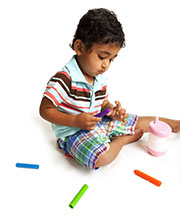Creative Arts
 The arts provide children with a vehicle and organizing framework to express ideas and feelings.
The arts provide children with a vehicle and organizing framework to express ideas and feelings.
Music, movement, drama, and visual arts stimulate children to use words, manipulate tools and media, and solve problems in ways that simultaneously convey meaning and are aesthetically pleasing. As such, participation in the creative arts is an excellent way for young children to learn and use creative skills in other domains. The component within this domain addresses a child’s willingness to experiment with and participate in the creative arts.
Children with disabilities may demonstrate alternate ways of meeting the goals of creative arts development. Children who cannot speak, for example, will focus on activities that are rhythmic rather than vocal, and children with hearing impairments will be able to respond to music by feeling the vibrations in the air. Children with cognitive disabilities also may reach many of these same goals, but at a different pace, with a different degree of accomplishment, and in a different order than typically developing children. However, the goals for all children are the same, even though the path and the pace toward realizing the goals may be different. Principles of universal design for learning (UDL) offer the least restrictive and most inclusive approach to developing environments and curricula that best support participation in creative arts for all children.
Remember:
While this domain represents general expectations for creative arts development, each child will reach the individual learning goals at their own pace and in his or her own way.
